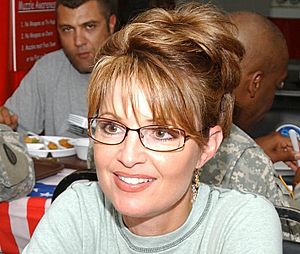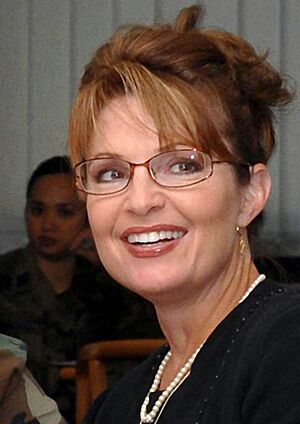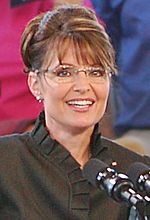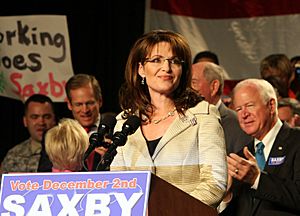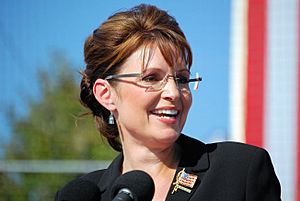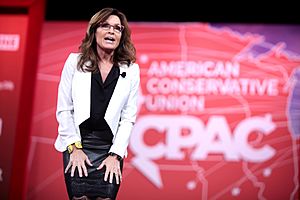Sarah Palin facts for kids
Quick facts for kids
Sarah Palin
|
|
|---|---|
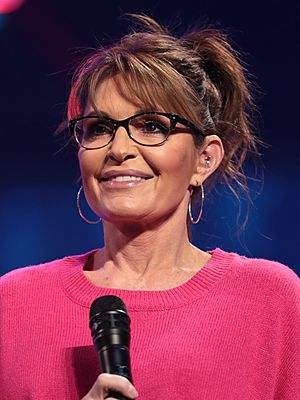
Palin in 2021
|
|
| 9th Governor of Alaska | |
| In office December 4, 2006 – July 26, 2009 |
|
| Lieutenant | Sean Parnell |
| Preceded by | Frank Murkowski |
| Succeeded by | Sean Parnell |
| Chair of the Alaska Oil and Gas Conservation Commission | |
| In office February 19, 2003 – January 23, 2004 |
|
| Governor | Frank Murkowski |
| Deputy | Mike Bill Randy Ruedrich Daniel Seamount |
| Preceded by | Camille Taylor |
| Succeeded by | John Norman |
| Mayor of Wasilla | |
| In office October 14, 1996 – October 14, 2002 |
|
| Preceded by | John Stein |
| Succeeded by | Dianne Keller |
| Member of the Wasilla City Council from Ward E |
|
| In office October 19, 1992 – October 14, 1996 |
|
| Preceded by | Dorothy Smith |
| Succeeded by | Colleen Cottle |
| Personal details | |
| Born |
Sarah Louise Heath
February 11, 1964 Sandpoint, Idaho, U.S. |
| Political party | Republican |
| Spouse | |
| Children | 5, including Bristol |
| Education | University of Idaho (BA) |
| Signature |  |
Sarah Louise Palin (born February 11, 1964) is an American politician, writer, and TV personality. She was the ninth governor of Alaska from 2006 to 2009. In 2008, she was the Republican candidate for Vice President of the United States. She ran alongside U.S. senator John McCain.
Palin started her political career on the Wasilla city council in 1992. She became the mayor of Wasilla in 1996. In 2003, she was chosen to lead the Alaska Oil and Gas Conservation Commission. This group makes sure oil and gas fields in Alaska are safe and work well. In 2006, at 42, she became the youngest person and first woman to be elected governor of Alaska. She left office in 2009.
Palin was chosen as John McCain's running mate for Vice President in 2008. She was the first Republican woman to run for Vice President. She was also the second woman from a major party to run for this role. The McCain-Palin team lost the 2008 election to Barack Obama and Joe Biden. Even though they lost, the election made Palin well-known across the country.
After leaving her role as governor in 2009, she supported the Tea Party movement. She also appeared on TV. From 2010 to 2015, she was a political expert for Fox News. She hosted TV shows like Sarah Palin's Alaska and Amazing America with Sarah Palin. Her book, Going Rogue, sold over a million copies. In 2022, Palin ran for a seat in the U.S. House of Representatives for Alaska but did not win.
Contents
Early Life and Education
Sarah Palin was born in Sandpoint, Idaho, on February 11, 1964. She was the third of four children. Her mother, Sarah "Sally" Heath, was a school secretary, and her father, Charles R. "Chuck" Heath, was a science teacher and sports coach.
When Sarah was a baby, her family moved to Skagway, Alaska. They later moved to Eagle River, Anchorage in 1969, and then settled in Wasilla, Alaska in 1972.
Palin played the flute in her junior high band. She went to Wasilla High School, where she was a leader in the Fellowship of Christian Athletes. She was also a member of the girls' basketball and cross-country running teams. In her senior year, she helped her basketball team win the 1982 Alaska state championship. This earned her the nickname "Sarah Barracuda" because she was very competitive.
In 1984, Palin won the Miss Wasilla beauty pageant. She also placed third in the Miss Alaska pageant, where she was named "Miss Congeniality." She played the flute for the talent part of the competition.
After high school, Palin went to several colleges before earning her bachelor's degree. She studied communications with a focus on journalism from the University of Idaho in 1987.
Early Career
After college, Palin worked as a sportscaster for TV stations in Anchorage. She also worked as a sports reporter for the Mat-Su Valley Frontiersman newspaper. This was something she had always wanted to do.
Political Career
Palin has been a member of the Republican Party since 1982.
Wasilla City Council
Palin was elected to the Wasilla City Council in 1992. She won by a clear margin.
Mayor of Wasilla
Palin ran for mayor of Wasilla in 1996. She was concerned about how the city's money was being spent. She won the election, beating the current mayor. She ran again in 1999 and won easily. She served two terms as mayor, which was the limit. In 1999, she became the president of the Alaska Conference of Mayors.
First Term as Mayor
As mayor, Palin used money from a new sales tax to lower property taxes. She also removed other business taxes. She used city bonds to improve roads and sewers. She also gave more money to the police department. She helped create new bike paths and got money to clean up water. She also cut the budget for the local museum.
Soon after becoming mayor, Palin asked city leaders to update their resumes. She wanted to know if they would support her plans. She also asked department heads to get her approval before talking to reporters. She created a new position called city administrator. She also cut her own salary by 10%, but this was later changed back by the city council.
Palin discussed removing a book from the library if people protested it. However, no books were removed from the library while she was mayor.
Second Term as Mayor
During her second term, Palin suggested building a city sports center. It would be paid for by a small sales tax increase and a bond. Voters approved the plan. The Wasilla Multi-Use Sports Complex was built on time and within budget. However, the city spent extra money because of a land dispute. The city's debt grew because of this project and other improvements.
Palin also worked with nearby towns to get money from the federal government. Her efforts helped Wasilla get nearly $8 million for projects. These included money for a youth shelter, a transportation center, and sewer repairs. The mayor who came after Palin said that Palin's tax cuts and improvements helped bring large stores and many shoppers to Wasilla.
Palin could not run for a third term as mayor in 2002 because of term limits.
State Politics
In 2002, Palin ran for the Republican nomination for lieutenant governor. She came in second. After that, she helped campaign for the Republican candidates for governor and lieutenant governor.
In 2003, Governor Frank Murkowski appointed Palin to the Alaska Oil and Gas Conservation Commission. This group watches over Alaska's oil and gas fields. Palin became the chair of the commission. She also became an ethics supervisor. She later resigned in 2004.
Governor of Alaska
In 2006, Palin ran for governor of Alaska. She promised to bring clean government. She defeated the current governor, Frank Murkowski, in the Republican primary. Her running mate was Sean Parnell.
In the November 2006 election, Palin won. She beat former Democratic governor Tony Knowles. She became Alaska's first female governor. At 42, she was also the youngest governor in Alaska's history. She took office on December 4, 2006. For most of her time as governor, she was very popular with voters in Alaska.
Palin said her main goals were to develop resources, improve education, and ensure public safety. She had promised to reform ethics during her campaign. Her first action as governor was to push for a new ethics law. She signed it in July 2007.
Palin often disagreed with the Republican leaders in Alaska. She supported Sean Parnell when he tried to unseat Don Young, a long-time U.S. Representative. She also pushed for more oil and natural gas drilling in Alaska. This included drilling in the Arctic National Wildlife Refuge.
In 2007, Palin traveled to Kuwait. She visited soldiers from the Alaska National Guard. On her way back, she visited injured soldiers in Germany.
Budget and Spending
In June 2007, Palin signed a record $6.6 billion budget. She also cut $237 million from the capital budget. This was one of the largest cuts in the state's history.
Palin kept a campaign promise to sell the state's private jet. The previous governor had bought it for $2.7 million. Palin sold it for $2.1 million.
Palin lived in Juneau during the legislative session. The rest of the year, she worked from offices in Anchorage. She claimed a travel allowance for this. Some people criticized her for this, but her staff said it followed state rules. They also noted her expenses were much lower than the previous governor's.
Federal Funding
Palin said Alaska should not rely too much on money from the federal government. During her time as governor, Alaska's federal representatives asked for less money for special projects.
Alaska does not have a sales tax or income tax. The state gets a lot of money from oil. In 2008, state revenues doubled to $10 billion. Even so, Palin asked for $197 million in federal money for 31 projects in 2009. This was much less than what her predecessor had asked for.
Bridge to Nowhere
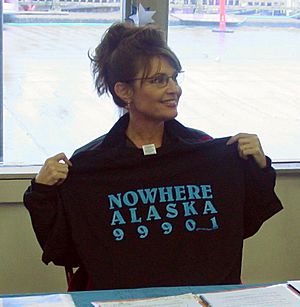
A plan was made in 2002 to build a bridge to Gravina Island near Ketchikan. This bridge was nicknamed "The Bridge to Nowhere" by critics. It was meant to replace a ferry service to the airport. In 2006, Palin had supported building the bridge. She said she would not let people make the project sound bad.
As governor, Palin canceled the Gravina Island Bridge project in September 2007. She said Congress was not interested in spending more money on it. Alaska did not return the $442 million in federal transportation funds. In 2008, as a candidate for Vice President, Palin said she had told Congress "thanks, but no thanks, on that bridge to nowhere." Some people in Ketchikan said this was not true.
Gas Pipeline
In August 2008, Palin signed a law to allow a company called TransCanada Pipelines to build a pipeline. This pipeline would carry natural gas from Alaska to the rest of the United States through Canada. The state also promised $500 million to help the project. This project was expected to cost $26 billion. Newsweek called it the main achievement of Palin's time as governor.
Predator Control
In 2007, Palin supported a policy that allowed hunting wolves from the air. This was part of a program to increase the number of moose and caribou for hunters. The state offered money to volunteer pilots and gunners to help with this. Wildlife groups sued the state, and a judge said the money offer was illegal. In 2008, Alaskans voted against ending the predator control program.
Resignation
On July 3, 2009, Palin announced she would resign as governor before the end of the month. She said that she and the state had spent a lot of time and money ($2.5 million) dealing with many legal and ethics complaints against her. She also said she didn't want to be a "lame duck" governor, meaning a leader who has little power left.
Lieutenant Governor Sean Parnell said that Palin's decision to resign was mainly due to the high legal costs from these investigations. Palin and her husband had personally paid over $500,000 in legal fees. Sean Parnell became governor on July 26, 2009, after Palin's resignation.
In December 2010, new rules for ethics in Alaska's government were put in place. These rules allow the state to pay legal costs for officials who are found innocent of ethics violations. They also allow family members of the governor or lieutenant governor to travel at state cost in some situations.
2008 Vice Presidential Campaign
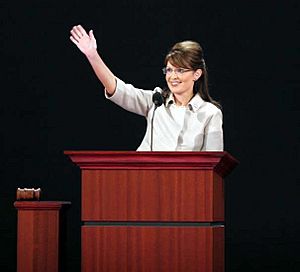
In the summer of 2007, some conservative commentators suggested that John McCain should choose Palin as his running mate for Vice President. They thought she would bring excitement to the Republican party.
On August 27, 2008, McCain offered Palin the position of vice-presidential candidate. Her selection was a surprise to many because she was not well-known outside Alaska. On August 29, in Dayton, Ohio, McCain introduced Palin as his running mate. This made her the first Alaskan and the second woman to run on a major U.S. party ticket.
Before her selection, Palin was largely unknown outside Alaska. On September 1, 2008, Palin shared that her daughter Bristol was pregnant. On September 3, Palin gave a speech at the 2008 Republican National Convention. Her speech was well-received and watched by over 40 million people.
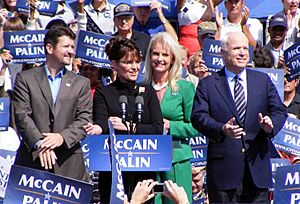
During the campaign, there was some debate about whether Palin's views had changed. Some media outlets said McCain's campaign was limiting reporters' access to Palin. Her first big interview, with Charles Gibson of ABC News, got mixed reactions. Her third interview, with Katie Couric of CBS News, was widely criticized. After this, her poll numbers dropped, and some Republicans worried she was hurting the campaign.
Palin prepared a lot for her debate with Democratic vice-presidential candidate Joe Biden on October 2. Polls found that while Palin did better than many expected, most voters felt Biden won the debate.
After the debate, Palin became more aggressive in her attacks on the Democratic presidential candidate, Barack Obama. She said it was time to "take the gloves off."
Palin appeared on Saturday Night Live on October 18. She had been famously parodied by actress Tina Fey, who looked a lot like her.
A controversy came up when it was reported that the Republican National Committee (RNC) spent $150,000 on clothes, hair, and makeup for Palin and her family. Campaign spokespeople said the clothes would go to charity after the election. Palin and some media outlets said this criticism was unfair because of gender bias. Palin later returned the clothes to the RNC.
The election was on November 4, and Obama was announced as the winner. In his speech, McCain thanked Palin, calling her "one of the best campaigners I've ever seen."
Experts have studied how Palin affected the 2008 election results. Some studies suggest her campaign performance might have slightly reduced McCain's final vote share.
After Being Governor
After the 2008 election, Palin continued to be a public figure. In January 2009, she appeared on Glenn Beck's TV show. She said she would help President Obama if it meant progress for the country.
In August 2009, she used the phrase "death panel" to describe parts of the proposed health care reform. She said it would lead to rationing of care. This phrase was criticized by many Democrats.
In March 2010, Palin started a TV show on TLC called Sarah Palin's Alaska. The first episode had five million viewers. She also had a segment on Fox News. She rejoined Fox News Channel as an analyst in 2013.
SarahPAC
In January 2009, Palin started a political action committee called SarahPAC. This group supports candidates for federal and state office. After she resigned as governor, Palin said she wanted to campaign for candidates who believed in the right things.
Going Rogue and America by Heart
In November 2009, Palin released her book, Going Rogue: An American Life. It talks about her life in politics and her decision to resign as governor. The book sold over one million copies in less than two weeks. It was a bestseller, like books by other famous politicians.
Palin traveled to many states to promote her book. She also appeared on TV shows, including an interview with Oprah Winfrey. In November 2010, she released her second book, America by Heart.
Tea Party Movement
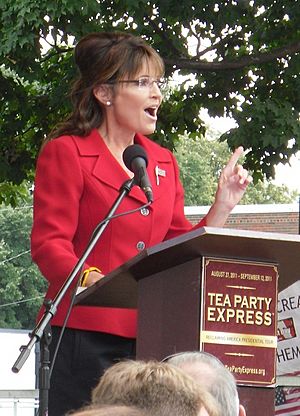
On February 6, 2010, Palin was the main speaker at the first Tea Party convention. She said the Tea Party movement was "the future of politics in America." She criticized President Obama for increasing debt.
In 2011, Palin spoke at other Tea Party rallies. She encouraged members to work together with other Republicans.
Endorsements
In 2010, Palin supported many conservative Republican women running for office. She called for a "stampede of pink elephants." She endorsed Nikki Haley for Governor of South Carolina, who later won.
Palin endorsed 64 Republican candidates in the November 2010 elections. She helped raise a lot of money for them. Her support for Joe Miller in Alaska helped him win the Republican primary for U.S. Senator. However, the incumbent, Lisa Murkowski, later won the general election as a write-in candidate.
Palin's support for Christine O'Donnell in Delaware also caused tension with other Republicans. Some said her endorsements might have cost the Republican Party some Senate seats.
2012 Election and Beyond

After the 2008 election, some people thought Palin might run for president in 2012. In November 2010, she said she was thinking about it. She also said it was time for a woman to be president. However, in October 2011, she decided not to seek the Republican nomination.
In 2014, Palin supported an independent and a Democrat for governor of Alaska. They ran against her former lieutenant governor, Sean Parnell. This was because she disagreed with Parnell's tax cuts for the oil and gas industry. The independent and Democrat team won the election.
In January 2016, Palin endorsed Donald Trump for president. She also said she would work to defeat Republican House Speaker Paul Ryan. Ryan later won his primary election easily.
2022 House of Representatives Candidacy
After the death of Alaska's congressman Don Young, Palin ran in the 2022 special election for the vacant seat. Former president Donald Trump supported her campaign.
Palin was one of three main candidates in the special election. She lost to Democrat Mary Peltola. Palin ran again in the November general election for the same seat but lost to Peltola again.
Political Positions
Palin has been a registered Republican since 1982.
Health Care
Palin was against the 2010 health care reform law. She said it would lead to government control over health care decisions, using the term "death panels."
Social Issues
Palin is against same-sex marriage and supports capital punishment.
Education
Palin supports discussing creationism alongside evolution in public schools. She believes evolution "should be taught as an accepted principle" and that her belief in God's role in creation is not part of school policy.
Guns
Palin is a Life Member of the National Rifle Association of America (NRA). She believes the Second Amendment protects the right to own handguns. She is against bans on semi-automatic assault weapons. She also supports teaching young people about gun safety.
Environment
Palin supports drilling for oil off-shore and on land in the Arctic National Wildlife Refuge. She believes that stopping domestic energy production does not solve global warming issues and can make them worse. After the 2008 election, Palin called studies supporting the scientific consensus on climate change "snake oil science." She criticized environmental laws as being a burden on businesses.
Foreign Policy
Palin is a strong supporter of Israel. She supported the George W. Bush administration's policies in Iraq. She believes the U.S. should take military action if there is an immediate threat. She also supported increasing the defense budget to maintain a strong military.
Palin was against the Obama administration's plan for military action in the Syrian Civil War in 2013. In 2008, she supported NATO membership for Ukraine and Georgia. However, during the 2022 Russian invasion of Ukraine, Palin suggested reducing U.S. military aid to Ukraine.
Palin opposed the Joint Comprehensive Plan of Action, which limited Iran's nuclear program. She felt the agreement was not strict enough.
Television Appearances
In 2016, Palin was a guest on the TV show Match Game.
In 2020, Palin was a contestant on The Masked Singer. She performed as "Bear." She said she did it as a "walking middle finger to the haters."
Personal Life
In August 1988, Palin married Todd Palin, her high-school sweetheart. They have five children: sons Track and Trig, and daughters Bristol, Willow, and Piper. Her youngest child, Trig, was born in 2008 with Down syndrome.
Todd Palin worked for an oil company and owned a commercial fishing business. He retired in 2009.
Palin was baptized Catholic as a baby. Her family later attended non-denominational churches. She then joined the Wasilla Assembly of God, a Pentecostal church. She attended the Wasilla Bible Church starting in 2002. She describes herself as a "Bible-believing Christian."
Todd Palin filed for divorce from Sarah in August 2019. The divorce was finalized in March 2020.
Images for kids
See also
 In Spanish: Sarah Palin para niños
In Spanish: Sarah Palin para niños


